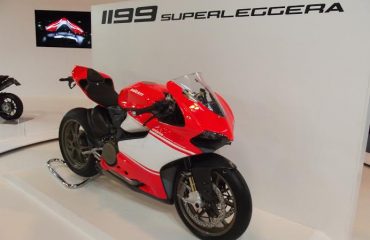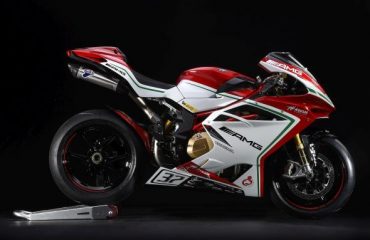Triumph Daytona 675R Review

Triumph Daytona 675R

A multiple Supersport Shootout winner, the refurbished Triumph Daytona 675R looks to win over test riders with its bubbly Triple and R-spec performance. Watch the result in the 2013 Triumph Daytona 675R Supersport Street video.
The Triumph Daytona 675R is no stranger to Supersport Shootout success, a three-time shootout victor since its 2006 model year debut. After some minor revamps, the 2013 model year features the first engine overhaul for the British bike’s signature Inline Triple. The R-spec 675 also sources top-shelf components and electronics, making it a more potent package than ever before.
Engineers tweaked Triumph’s 675cc Inline Triple to be more oversquare, with a 76mm bore and 49.6mm stroke (from 74mm x 52.3). Compression is bumped and the valvetrain swapped for lighter parts. The new engine ran the dyno up to the tune of 113.68 horsepower and 49 lb-ft of torque. That’s a modest 3 hp increase from the previous model and slight decrease in peak torque, but this Daytona sports a fatter torque curve in the bottom and mid-range. The 600s catch up start catching up to the Triumph on the top end, and the Kawasaki 636 actually does. But the British Triple is all about the torque down low, where it surges well above all but the Ducati and Gixxer 750.
The translation on the street is an engine with plenty of pulling power across the entire powerband. Sporting the flattest torque curve in the test, the Triumph Triple makes for a practical and playful ride.
“Power from the 675R is perfect for the street,” confirms Adey. “It has great mid-range for pulling away from traffic when needs be. And it has the top-end grunt to put a big smile on your face when the road is clear ahead for full-tuck assault.”
Brimming with street-friendly torque, the Triumph Triple is also one of the most grin-inducing engines in this class. That’s old news for anyone who’s read past shootouts with a Triumph in the mix, but in this case the British bike gets one-upped by the thrilling Triple from MV Agusta. The Italian mount sounds better on the pipe, though the Triumph isn’t far behind.
“The Triple’s engine character, with its orgasmic throaty sound and smooth power delivery, made it most enjoyable to ride,” says Adey.
“The one thing that keeps bothering me when I ride a three-cylinder Triumph is the ‘whistle’ that can cover the exhaust and engine sound,” notes a keen-earned Massimo, before allowing the Daytona mill “has character and personality.”
The Triumph drivetrain makes huge gains in 2013 with its quickshifter and slipper clutch. While the gear lever actuation isn’t quite as smooth as the Japanese rides, the Daytona’s six-speed package is both forgiving and efficient. It stands out in this test as the only bike with both a quickshifter and slipper clutch, and each one performs well.
“The slipper clutch on it specifically, man you can jam down the gears and it never chattered, never got you out of shape,” says Nathon.
Riding the well-sorted Japanese bikes, riders can be forgiven for questioning the value of a quickshifter. But the Triumph’s bang-bang immediate upshifts will have them wishing every bike was provisioned so. The shifter proves valuable on the track, but just as convenient on the street. The electronic shifter also aided during performance testing, where Adam coaxed the Daytona to a second-fastest 0-60 at 3.5 seconds. In the quarter-mile the Daytona records the third-fastest time at 11.29 seconds.
The Triumph trails only the Kawasaki in handling and braking performance, and by the slimmest of margins. And tweaks to the steering geometry, with a steeper rake, make for a sharper turning chassis.
“The 675R felt solid all the way around in the handling department,” says Adey. “Given it comes equipped with full Ohlins sus¬pension and Brembo brakes. I expected no less than what I felt – a 10 out of 10 for me.”
The Ohlins units are a fully-adjustable NIX30 fork and TTX36 shock and performance from both live up to their spec sheet billing. Where the Showa BPF units offer stability and a planted feel, the Triumph’s Ohlins suspension package goes one step further. They damp out the inconsequential white noise coming up from the road, yet transmit immediate, precise feel. And while the Triumph turns so quick that a rider expects it to twitch and lift up front, instead transitions are smooth and controlled.
The modulation and lever feel afforded by the Triumph braking package is the best of the Brembo monobloc units in this test. Only the Kawasaki’s surprising Nissin setup rates higher – and, again, by an almost imperceptible margin.
“Stopping power is immense due to its Brembo hardware. Lever feel is progressive upon initial pull, making for no-alarm braking,” says Adey, with Massimo agreeing: “Together with the Ohlins, I think it was the best combination – with effortless breaking.”
ABS comes standard aboard the 675R, the only bike to do so. The system is switchable, with three settings: On, Off and Circuit. High-performance addicts will appreciate the second setting, insisting on their superior control and unhindered stoppie/rear-slide shenanigans. The rest of us mortals will enjoy the safety cut-in, and Circuit mode allows for a generous degree of tire slip.
Ergonomics on the Triumph haven’t been the highlight of the Daytona in the past, particularly for the street. It’s still not as comfy as the 600s, but this year it did seem improved in our tester’s opinions.
“Although they gave this bike a full revamp it feels pretty similar to the old one behind the windscreen,” admits Adam. “It still feels narrow, but it’s less top heavy and the ergonomics feel more balanced and GSX-R like.”
Adey likes the riding position too, saying: “Ergos on the 675R felt like a perfect balance between go fast now… chill later.”
The Daytona’s dash showcases all the necessary info in a concise space. The prominent right-side analog tach allows for programmable shift lights – a track-oriented feature to be sure, but another indication of the 675R’s race-bike build quality. The Triumph hasn’t always felt so top-shelf.
“The Daytona 675R is a quality motorcycle, and the fit and finish appears on the same level of the Japanese machines, which is a big improvement for Triumph,” says Adam. “I also LOVE the way it looks in white.”
In the appearance rankings, only the F3 rates higher than the Daytona. This result, along with the MV stealing the Triumph’s other usual gimmie on the scoresheet, engine character, may furrow some British brows… And it is ironic that the Triumph gains so much over on the Japanese because they are boringly similar, and yet it falls short in personality to the copy-cat MV. But the raw and ragged F3 has a long ways to go before it can displace the super refined Daytona.
The Daytona eeks out another Supersport victory with its high-performance chassis and engaging personality. Triumph’s Inline Triple continues to deliver, and the rest of the component package has improved as well – a shootout winning formula.




